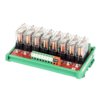roadmonster
Member
Let your car dictate how your wiring system develops.
I rewired my buggy last year and more or less accidentally did it right. I started with the ideas of accessibility, excess capacity, versatility, and short wire runs. I used several fuse blocks, terminal strips, distribution blocks, and relays and laid things out where they worked best. I ended up with 2 6-fuse blocks (one hot, one switched) side by side left of the column. 2 marine terminal strips for power and ground next to that. 12x4 push-on terminal strip behind the gauges. This is REALLY useful (no, I don't know where to get another one). 4-relay panel next to that. Now you have everything you need under the dash and the wires push on so you can rearrange things however you want.
In the grille shell is another 6-fuse block for hi beams, lo beams, fan, and horns. Very short wire run directly from alternator.
Behind the seat is a spare block which powers an 800w sub and (2) 700x2 amps. It's mostly empty but available for future expansion if needed.
When you distribute the components, you utilize otherwise wasted space and have full 12v right at the load. Taillights and audio amps are right off the battery, lights, fan, and horns are right off the alternator, and dash accessories are off marine terminals with 12ga wire direct to battery.
If a fuse ever blew, you can keep extra ones in the spare slots and either replace the fuse or move the wire over to the spare circuit. If you decide to relay a circuit, it's just plug and play. Troubleshooting and reconfiguring things is very easy.
Just my thoughts. Good luck!
I rewired my buggy last year and more or less accidentally did it right. I started with the ideas of accessibility, excess capacity, versatility, and short wire runs. I used several fuse blocks, terminal strips, distribution blocks, and relays and laid things out where they worked best. I ended up with 2 6-fuse blocks (one hot, one switched) side by side left of the column. 2 marine terminal strips for power and ground next to that. 12x4 push-on terminal strip behind the gauges. This is REALLY useful (no, I don't know where to get another one). 4-relay panel next to that. Now you have everything you need under the dash and the wires push on so you can rearrange things however you want.
In the grille shell is another 6-fuse block for hi beams, lo beams, fan, and horns. Very short wire run directly from alternator.
Behind the seat is a spare block which powers an 800w sub and (2) 700x2 amps. It's mostly empty but available for future expansion if needed.
When you distribute the components, you utilize otherwise wasted space and have full 12v right at the load. Taillights and audio amps are right off the battery, lights, fan, and horns are right off the alternator, and dash accessories are off marine terminals with 12ga wire direct to battery.
If a fuse ever blew, you can keep extra ones in the spare slots and either replace the fuse or move the wire over to the spare circuit. If you decide to relay a circuit, it's just plug and play. Troubleshooting and reconfiguring things is very easy.
Just my thoughts. Good luck!














